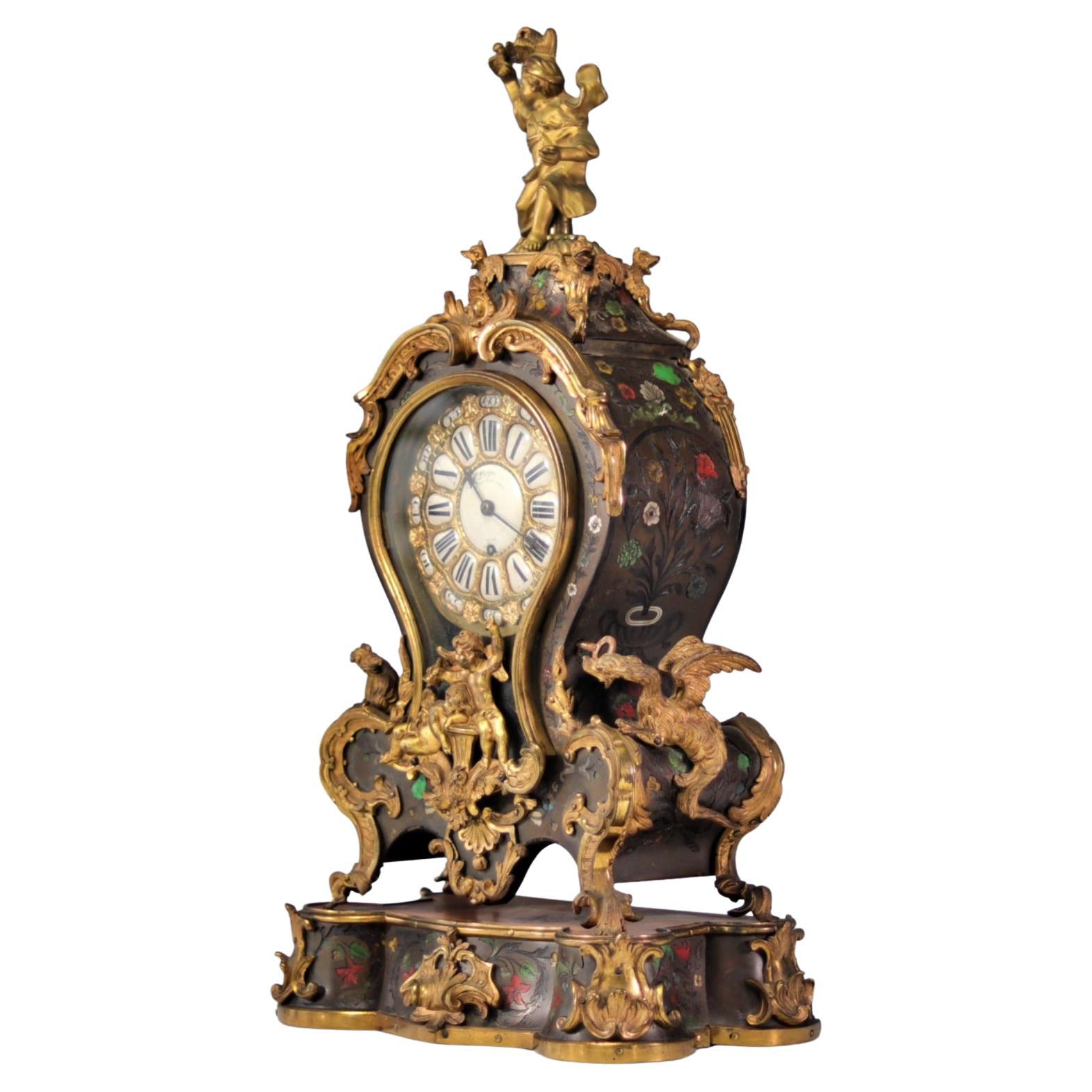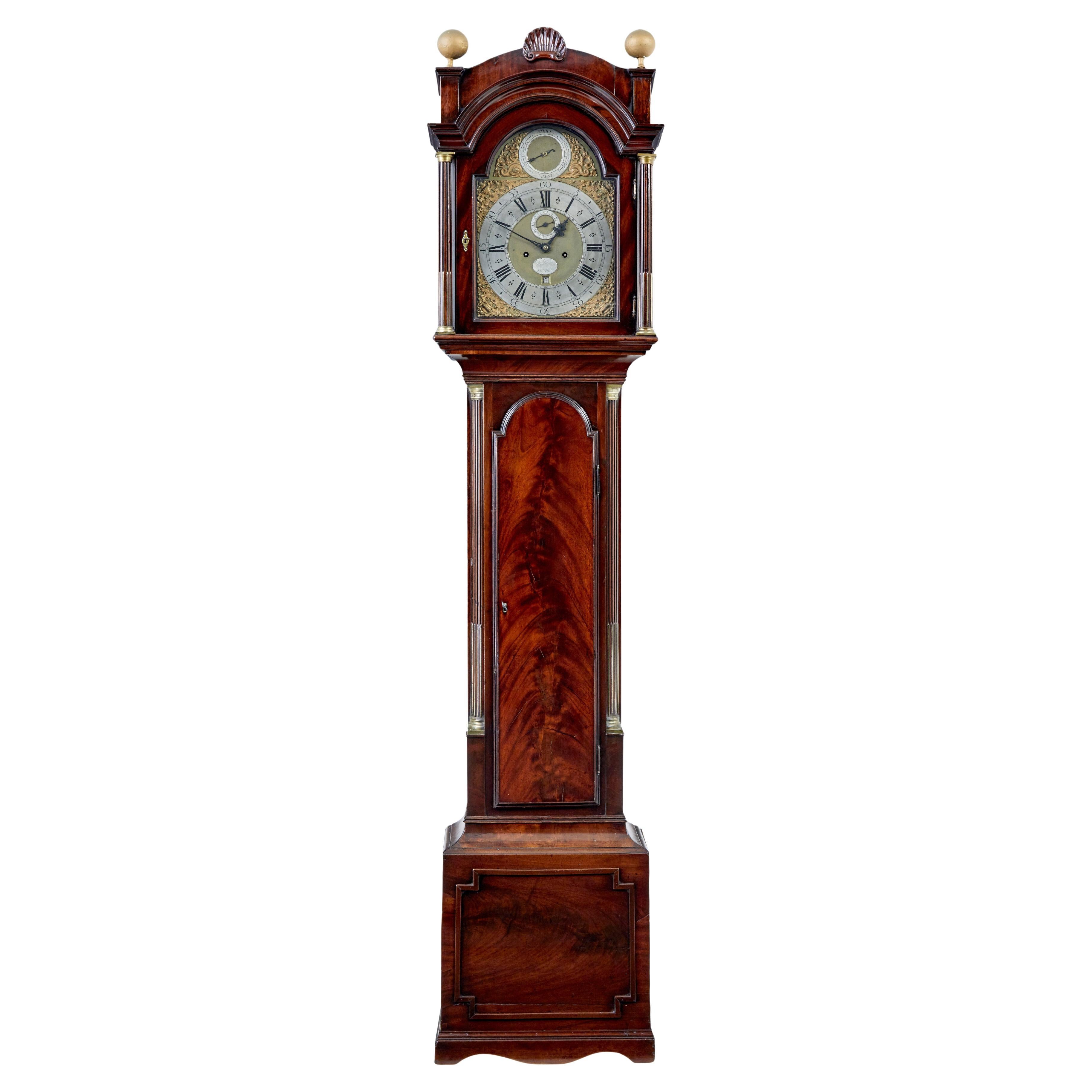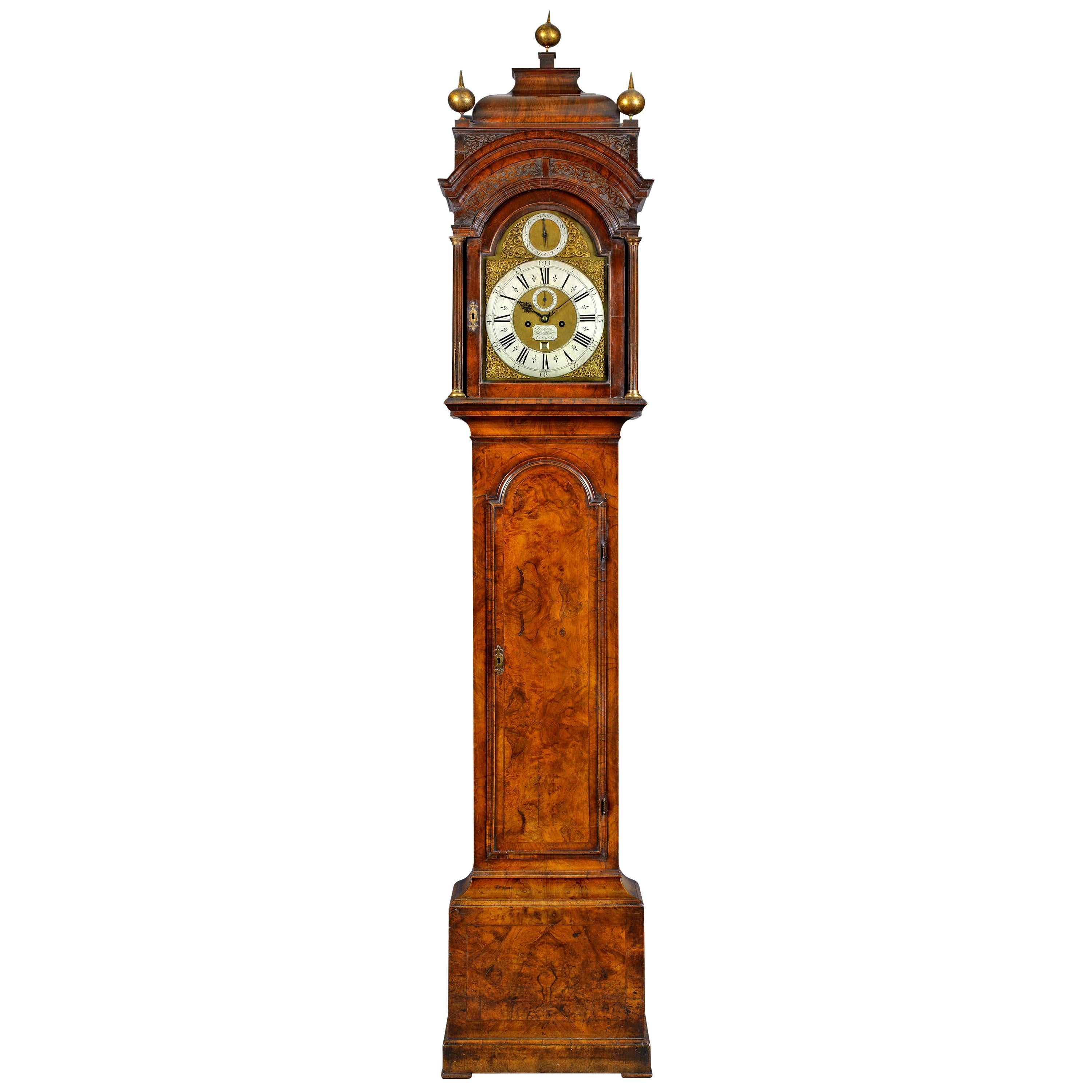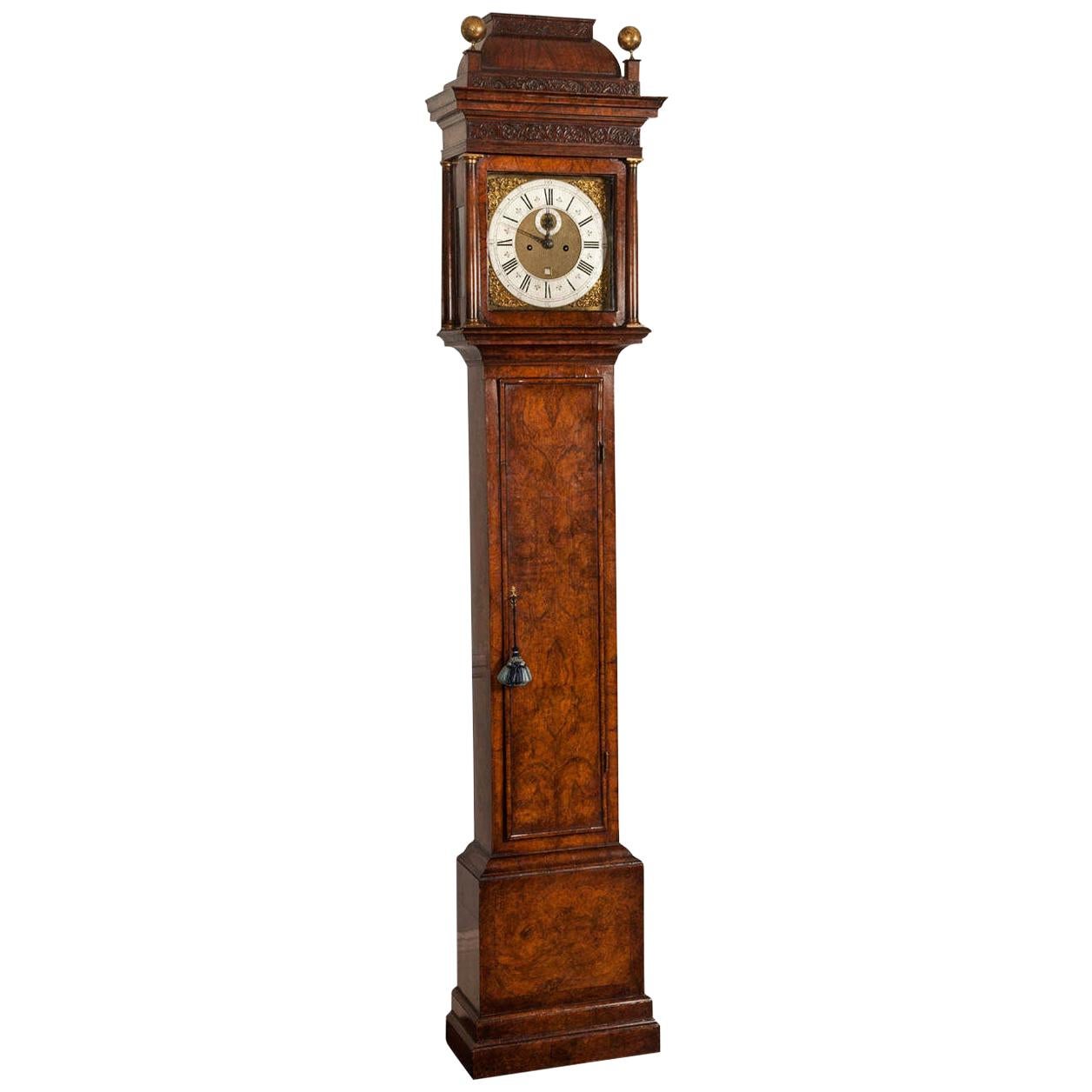Items Similar to 18th C. English Pine Curtis & Horspool London Act of Parliament Tavern Clock
Want more images or videos?
Request additional images or videos from the seller
1 of 10
18th C. English Pine Curtis & Horspool London Act of Parliament Tavern Clock
About the Item
"18th century monumental museum quality Act of Parlament clock. Made from pine with a large round face over elongated case. Features an enameled metal face marked Curis Horspool in Leicester, London England. Curis was the royal watchmaker of the Prince of Wales.
As a result of an Act passed by the English Parliament in 1797 tavern clocks were hung in every pub and tavern throughout the British Isles. The Act declared that a tax would be collected on every clock in the realm.
As a result many private clock owners either hid their clocks or got rid of them altogether. Thus taverns and pubs became the preferred location for obtaining the correct time. The Tavern owners did not mind paying the tax because the towns people had to stop by if they wanted to find out what time it was. This resulted in more people eating and drinking at the Tavern.
An ""Act of Parliament clock"" is a type of large weight driven wall clock originally hung in inns and taverns in the United Kingdom, beginning in the mid-18th century. Such clocks were plain in design, the faces were around two to five feet in diameter, and they were hung on the wall. They were also commonly called Tavern Clocks.
The term ""Act of Parliament clock"" came about long after these clocks were already in existence. In 1797, a tax against clocks of five shillings was introduced in the Kingdom of Great Britain by the Prime Minister William Pitt. The tax was very unpopular among clockmakers and was repealed after nine months. The large clocks in inns were later popularly said to have been developed as a response to this tax.". Measures: 86".
- Dimensions:Height: 86 in (218.44 cm)Width: 12 in (30.48 cm)Depth: 40.5 in (102.87 cm)
- Style:British Colonial (In the Style Of)
- Materials and Techniques:
- Period:
- Date of Manufacture:18th Century
- Condition:Wear consistent with age and use. Good Antique Condition; Missing Pendulum & Glass face.
- Seller Location:Dayton, OH
- Reference Number:
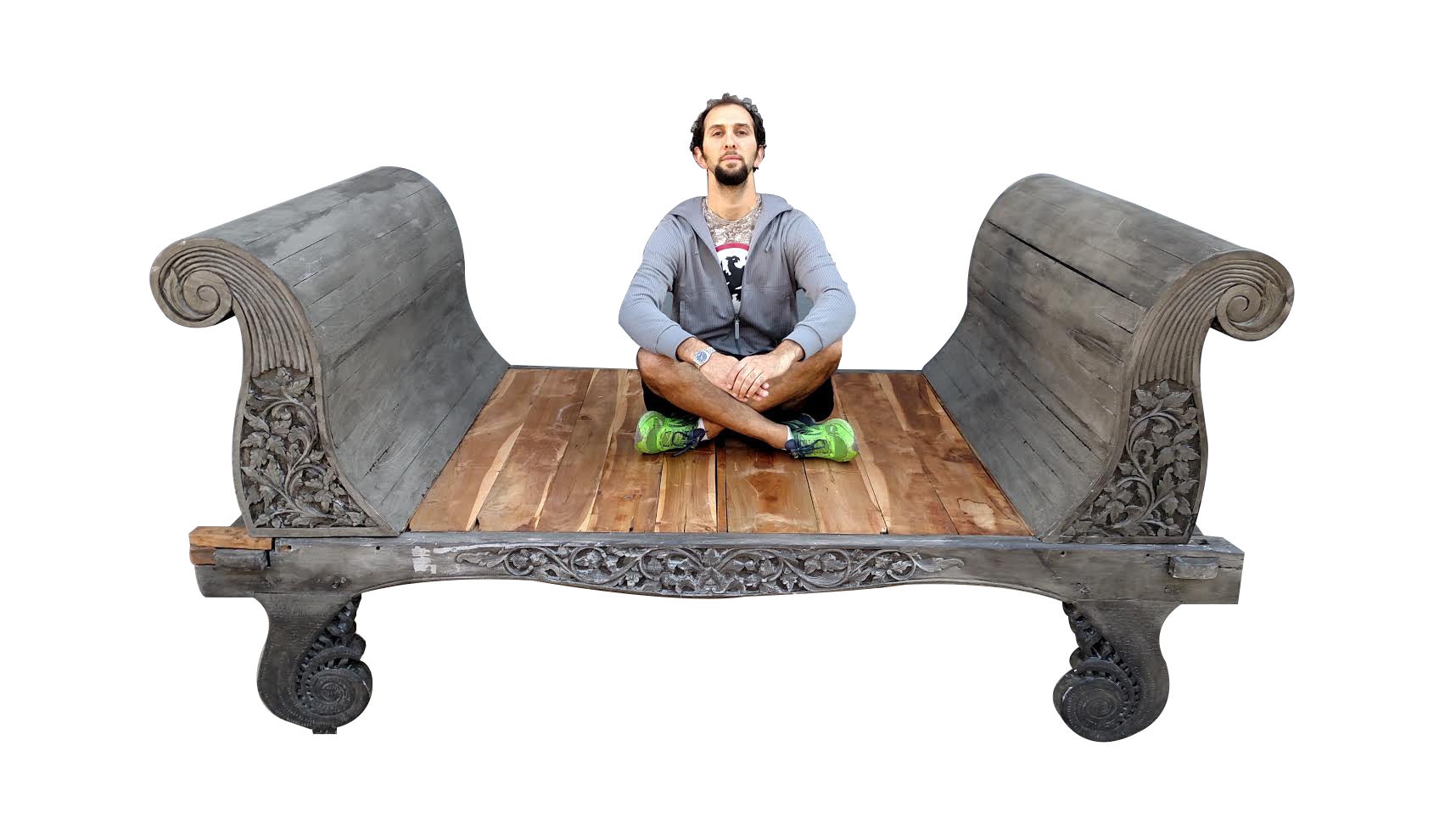
About the Seller
4.9
Platinum Seller
These expertly vetted sellers are 1stDibs' most experienced sellers and are rated highest by our customers.
Established in 2010
1stDibs seller since 2020
1,121 sales on 1stDibs
Typical response time: <1 hour
- ShippingRetrieving quote...Ships From: Dayton, OH
- Return PolicyA return for this item may be initiated within 2 days of delivery.
More From This SellerView All
- Antique English 19th Century 8 Day Fusee Skeleton Cathedral Glass Dome ClockLocated in Dayton, OHAntique mid 19th century 8 day skeleton clock. Centrally mounted on wood base featuring exposed Fusee movement and protected from dust by a glass dome.Category
Antique Mid-19th Century Victorian Table Clocks and Desk Clocks
MaterialsGlass, Hardwood
- Vintage Victoria Station 1747 Double Sided Brass Wall Mount Railway Clock 18"Located in Dayton, OH2 Available - Late 20th century double sided railway clock styled after the famous clock at Victoria Station, London. Wrought metal wall mounted support and case in a dark bronze fin...Category
Late 20th Century Victorian Wall Clocks
MaterialsBrass
- Vintage Victoria Station 1747 Double Sided Brass Wall Mount Railway Clock 18"Located in Dayton, OHLate 20th century double sided railway clock styled after the famous clock at Victoria Station, London. Wrought metal wall mounted support and case in a dark bronze finish. 12 inch d...Category
Late 20th Century Victorian Wall Clocks
MaterialsMetal
- Antique 19th Century French AD Mougin Gilt Bronze Mantel Garniture Clock & UrnsBy A.D. MouginLocated in Dayton, OH"Antique AD Mougin French figural garniture clock and mantel urns. Made of marble and bronze with gilt accents and neoclassical styling featuring a figural b...Category
Antique Late 19th Century French Provincial Garniture
MaterialsMarble, Bronze
- Antique French 19th C Japy Fil Classical Figure Bronze Slate Marble Mantel ClockBy Japy FrèresLocated in Dayton, OHA beautiful 19th Century French Mantel Clock. Features a seated woman in the thinker position. She is wearing a large flowing dress, sitting on a Klismos chair with footed raised ove...Category
Antique Late 19th Century French Provincial Mantel Clocks
MaterialsSlate, Bronze
- Rare Self Winding Clock Co Naval Observatory Time Western Union Wall Clock 26"By Self Winding Clock Co.Located in Dayton, OHAntique Western Union, Naval Observatory Time, self winding clock. Features a tall wooden case with carved corners and pediment mounted with tin sign reading "Naval Observatory Time Hourly By Western Union. White metal face with black Roman numerals and hands. Interior of case labeled "Property of Self-Winging Clock Co New York" and serial number on metal tag as well as on works. F Style / Vibrator movement, Serial Number 92630 (likely manufactured before 1917). Patented Oct. 4, 1898 by the Self Winding Clock Company. Fitted with Archer AC Adapter. "The Self Winding Clock Company (SWCC) of New York began business in 1886 marketing their own electro-mechanical clocks based on the 1884 electro-mechanical clock patent of one of the company founders, Chester Pond (1844-1912). The innovative principle of this clock mechanism was the incorporation of a small electric winding motor that automatically rewound the mainspring after the clock ran for one hour. The clocks were powered by batteries. The batteries would last at least one year. By being automatically rewound each hour, the strain on the mechanism was kept to a minimum, resulting in a very accurate timepiece. At about the same time SWCC began selling clocks, Pond was developing an electro-mechanical synchronizer attached to the clock movement that could synchronize the clock hands to an accurate time source. The synchronization occurs when a remote, precisely timed, electrical impulse is sent via wires connected to the individual clocks. By 1887 the synchronizers had been so improved that the Self Winding Clock Company could not only market individual clocks but also sell entire synchronized clock systems. By the 1960’s the days of individual elegant mechanical timepieces and synchronized time systems were over. SWCC ceased operations in the late 1960’s. All company records and inventories were relegated to the trash pile. The STYLE “F”, or as commonly referred to, the VIBRATOR movement was developed by Frederick M. Schmidt in the late 1890’s. By 1898 the “F” movement was being installed in almost all SWCC clocks. The movement has a Graham dead beat escapement. The “F” movement incorporates both the time train and winding motor in one set of plates. The motor used a single pair of coils. It was more reliable and easier to service than the rotary movement. The mainspring is re-wound after running for one hour. The vibrating armature oscillates up and down carrying a winding lever with a pawl that turns the winding wheel. The “F” movement was used in individual clocks and in clocks that were part of synchronized systems. It was made in 60, 80,120 and 140 beat versions. There were virtually no changes to the movement in 60 plus years the movement was in production. Almost all Style “F” movements wound on 3 volts DC. Style “F” movement serial numbers started in the 33,000’s and the first movements were probably made in 1898. The earliest plates had patent dates of 1891, 1892 & 1898. Serial numbers with these patent dates go up to the 63,000’s and were made before 1908. By 1908 the plates only had the 1898 patent date. By using catalog images of movement serial numbers it can be concluded that movements with serial numbers up to 112,000 were made in or before 1917. Movements with serial numbers up to 196,000’s were made in or before 1929. The single patent date serial numbers go as high as 220,000’s. Then there appears to be a large numbering gap. Finally, movements appear with no patent dates and serial numbers with the prefix FR. These numbers start at 300,000 but only continue to about 302,000. Start again at 400,000 and continue to about 402,000. Based on the large serial number gaps, the total number of “F” movements manufactured is probably around 200,000. They were manufactured between 1898 and possibly as late as the 1950’s. SWCC both sold clocks to and partnered with their biggest customer, Western Union in a nationwide distribution of precisely accurate “Naval Observatory Time” clocks. These either 120 or 140 beat Naval Observatory clocks...Category
Early 20th Century Late Victorian Wall Clocks
MaterialsMetal
You May Also Like
- 18th Century George II Tavern or Act of Parliament Clock, Circa 1740By Thomas MooreLocated in Oxfordshire, United KingdomTavern clock by Thomas Moore Ipswich A fine eighteenth-century tavern clock with a japanned shield dial and gilt decorations, signed at the bottom o...Category
Antique 18th Century English George II Wall Clocks
MaterialsOak, Pine
- Rare 18th Century English ClockBy Europa AntiquesLocated in Madrid, ESRare 18th century English clock Marquetry Weight: 9.20 kg England Sizes: H 62cm L 31cm very good condition.Category
Antique 18th Century English British Colonial Table Clocks and Desk Clocks
MaterialsBronze
- Late 19th Century Japonisme Gilt Metal Mantel Clock by Curtis & Horspool, ParisLocated in Los Angeles, CAAlluring gilt metal mantel clock in "Japonisme" style; an artistic movement influenced by Japanese aesthetics. Made in 1895 by Curtis & Horspool, Pa...Category
Antique 1890s French Mantel Clocks
MaterialsMetal
- 18th century mahogany longcase clock John Purden of LondonLocated in Debenham, SuffolkLate 18th century mahogany longcase clock John Purden London circa 1790. Georgian longcase clock in mahogany circa 1790. Movement made and signed by the well known movement maker jo...Category
Antique Late 18th Century English Georgian Grandfather Clocks and Longca...
MaterialsMetal
- 18th Century Antique Walnut Longcase Clock by James Blackborow of LondonBy James BlackborowLocated in Devon, GBAn antique George II period patinated, walnut longcase clock by James Blackborow of London. This finely figured veneered clock with elegant propo...Category
Antique Mid-18th Century English George II Grandfather Clocks and Longca...
MaterialsWalnut
- 18th Century Antique Walnut Longcase Clock by Daniel Delander of LondonBy Daniel DelanderLocated in Devon, GBThis superb George I period antique longcase clock by Daniel Delander is cased in highly figured walnut veneer of lovely colour and patina. Standing on a double plinth there is a panelled base and moulded trunk door. The pull forward hood is flanked by quarter columns with brass capitals. The case retains the original caddy top surmounted by two finials. The square dial has an applied chapter ring with cherubin spandrels. The dial centre is finely matted with an engraved date aperture and subsidiary seconds dial. The original blued steel hands appear to be original and are finely wrought and pierced. The movement is of eight day duration striking the hours on a single bell Daniel Delander worked with Thomas Tompion...Category
Antique Early 18th Century British George I Grandfather Clocks and Longc...
MaterialsWalnut
Recently Viewed
View AllMore Ways To Browse
18th Century London
18th C English
Antique Clocks London
Antique Clock London
English Antique Clocks
Antique English Clocks
Antique English Clock
The Tavern
Tavern Furniture
Wall Object Round
Antique Clocks In London
Long Case Clock Antique Clocks
Two Faced Clock
English What Not
Antique Pub
Antique Pubs
Antique Wall Clock Case
Antique Wall Clock Case Clocks

